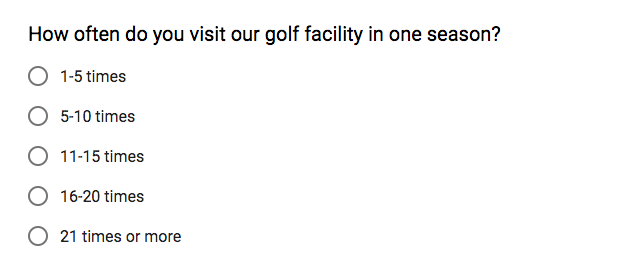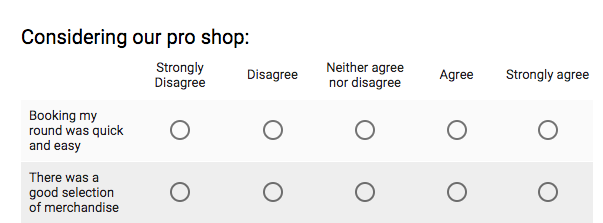
Success in the golf industry hinges on one factor…
How satisfied are your customers with the product or service you provide?
Whether you’re at a high-end private club, a 9-hole municipal course, or a driving range just off the highway, customer satisfaction is the primary factor that will bring customers back, inspiring them to support your facility and the various amenities you offer, driving business forward to additional profits and increased play.
Understanding that most customers will not express their discontent directly with you, but will do so with a dozen of their closest golfing friends, determining their level of satisfaction is most-easily accomplished by simply asking them. “How was your experience? Did you have a good time? Is there something we can do better?” Getting feedback from customers soon after a visit at your course allows you to take appropriate business decisions to increase overall customer satisfaction.
Many facilities are taking it a step further and implementing customer satisfaction surveys, in which they are asking the questions that will flesh out any negative experiences had on your property so you can address them in a timely and professional manner, turning a negative into a positive and leaving the customer satisfied.
What is a Customer Satisfaction Survey and Types of Surveys?
Simply put, a customer satisfaction survey is the process of determining the level of satisfaction that you provide your customers after they’ve interacted with your business. In golf, customers may be private club members, in which case you are gauging long-term satisfaction, public course golfers, from whom you want to learn any deficiencies in your daily processes or staff interactions, or many other range, retail, or instruction-based clientele, with whom you want to discuss the good and bad of your products and services and what you can do better.
Customer Satisfaction as a Number – C SAT
If you’re ready to take an honest look at how customers are feeling about your business, a customer satisfaction survey is the best way to do that. A successful customer satisfaction survey measures customer satisfaction, or C SAT, through a range of questions. By dividing all positive responses by the total number of responses and multiplying by 100, you get a tangible C SAT metric that will help you evaluate staff, training, process and procedure, rates, cleanliness, the caliber of your merchandise, the quality of your food and beverage operation, and the overall attractiveness of your facility, to name a handful. A public course with many different customers coming and going throughout the golf season, some frequent and some merely occasional, can benefit most from this method.
Net Promoter Score – NPS
NPS is a benchmark that many companies use to gauge employee and customer satisfaction. It measures an overall feeling about your facility, rather than one specific scenario. A C SAT score may be low for one particular visit, but the NPS derived from the same customer may remain high, as they understand that no one is perfect and appreciate you addressing the issue via the survey. The questions are typically asked with a range of answers from 0 to 10. The scores are usually classified into three groups – 9-10 are promoters – love what you’re doing, 7-8 are passives – not sold on what you’re offering but also not dissatisfied enough to say so, and 0-6, detractors – these are the ones who will tell ten of their friends and so on and so on. The total number of promoters minus the total number of detractors is your NPS. A business can learn a lot about itself and its operations through these results.
Customer Effort Score – CES
This vital indicator is a reflection of the ease or effort a customer must make to have their request handled. Anyone who’s experienced being transferred from one representative to another in trying to get a question answered or concern addressed knows the frustration a customer feels when he or she is working harder than the individuals or the process that should be servicing them.
Why Should You do Customer Satisfaction Surveys?
All of these methods are conducted in an effort to ensure exceptional customer service and a satisfactory customer experience. Your customer retention, sales, revenues, and bottom line all hinge on these results – but you and your staff have the power to dictate what is said about your facility. Conducting customer satisfaction surveys gives your business actionable insights for improvement. Their purpose extends beyond simply righting a wrong or rectifying a negative situation.
Liz Cooper, the Head Professional at Springfield Golf and Country Club, in Springfield, Virginia, has conducted surveys throughout her career to determine how satisfied her members are with the player development programs being offered, and to consider what new programs they would like to see implemented. “They wanted beginner programs, group clinics, classes with individuals of similar abilities that gave them an opportunity to learn, socialize, and have fun as well. Some of our more-experienced players, ten-handicaps and better, wanted group clinics for their level of play as well.” Her efforts in this area have ensured all members are served in the programs she offers – without asking, you often are left in the dark.
Inquiring with customers enables you to identify your biggest supporters, those who love what you’re doing and will help spread the word. It is a known fact that dissatisfied individuals will more-freely share their opinions than those who are very satisfied. It is important to utilize the good will that comes from a happy customer. For those who desire changes, surveys can extract their thoughts and feelings, giving them an opportunity to express their discontent, request additional programming, or highlight a staff interaction that may lead to valuable training and follow up with the staff member involved.
It is understandable, no manager dreams about doing a customer satisfaction survey. It can be a tedious and lengthy process, asking the right questions that will lead to the most useful feedback, resulting in the most positive outcome for customers and business. If you don’t, however, give your customers a forum to communicate their experience with you, they will do it elsewhere, often with detrimental impact on your business.
How to Write Customer Satisfaction Surveys?
To get the most effective feedback from survey participants, it is vital to ask the right questions. Years of research and advanced statistical analysis have gone into developing best practices for engaging customers in surveys – it is not unlike writing a club newsletter or designing a new website, you need to create a survey that is easy for customers to understand and complete. Some desired feedback requires multiple choice questions, generally ranking a level of service, whereas sometimes open-ended questions are more suitable, allowing the participant to express his or her opinion in detail.
To better understand the basics, the following are some of the more frequently used forms of survey questions.
Binary Questions
These questions have two possible answers – could be Yes or No – could be True or False. You get straightforward answers with no elaborating detail with these kinds of questions.
Examples: Are you satisfied with today’s experience? Was the instructor on time? Was the locker room clean?
These binary questions provide easy-to-compile results but do not get to the cause of any negative scenarios or the reason for any positive. Also, asking too many binary questions can cause respondents to lean towards positive answers, a phenomenon known as survey fatigue. As a result, you should limit the number of binary questions, and you’ll get more exacting results. Ideally, your survey should take no longer than 5 minutes, that amounts to roughly 10 questions.

Multiple Choice Questions
This kind of question is perfect for categorizing demographic information. Typically, three to five mutually-exclusive variables are given, with a clear segment in which any respondent would fit.
You could ask multiple-choice questions to determine a player’s playing ability, education level, income status, or profession. With these categories, you could segregate players based on these categories and analyze differences between each group.
Example: On average, how often do you visit our golf facility per season?

Make sure you know precisely why you’ll benefit from understanding these variables. Too many multiple-choice questions will also induce survey fatigue. So be careful to use variables that are relevant to determining customer satisfaction only.
Likert Scale Questions
Likert scale questions are one of the most common survey formats used to measure customer satisfaction. A very common question used in this type of survey:
“How satisfied were you with your experience today?”
Your answer possibilities may look like this:

Unlike a binary question with Satisfied vs. Dissatisfied or Agree vs. Disagree, Likert Scale Questions allow for various degrees of Satisfaction or Dissatisfaction. Also, the scale makes segmentation very easy, as you will be able to analyze trends and similarities between those who entered the same response. You can also track response changes over time to see whether your business is improving or not.
The only real disadvantage is that scale questions don’t provide any qualitative analysis. That is to say, it won’t tell you why your customers responded in a certain manner. If the ‘why’ is as important as the ‘what’, and you often can’t rectify the ‘what’ without the ‘why’, it is time to consider some open-ended questions. This allows respondents to provide their thoughts in detail, justifying the reason for their responses.
Open-Ended Questions
Your binary and/or scaled survey questions will tell you what customers are feeling. They will give you a snapshot, a preview if you will, of how satisfied your customers are with the product you are providing. Open-ended questions will tell you why. This qualitative feedback is essential because it helps you understand what each customer values as an individual, what he or she loves about your facility, and what they need to see changed to increase his or her level of satisfaction. This is a huge catalyst in customer retention. As mentioned earlier, knowing who your biggest fans are is a big deal – these individuals will support your business and encourage others to do the same. The individuals who were slightly less pleased may be only one or two minor changes away from joining your fan club – that’s why it is vital to understand why they answered the way they did.
Kevin Walls, a PGA Master Professional and a Career Consultant with the PGA of America says that meeting the needs of all your customers is a challenge. In the case of private clubs, your customers are often the owners of the club (the members). Some are more vocal/demanding than others, and finding the balance that leaves everyone satisfied is a task not easily accomplished.
“All clubs have vocal members with opinions and most do not represent the view of the entire membership. The most valuable resource for a club manager is having factual data to counter these opinions,” Walls told us.
Open-ended questions allow for much flexibility, for example: “What did you enjoy most about your visit to our golf course?”
You may get an array of answers highlighting the many amenities you offer and the customer service you provide.
In addition, you can use open-ended questions to allow the respondent to elaborate on a binary, multiple choice or Likert Scale survey question.
Examples: Did you enjoy your visit with us?
- Yes
- No
If no, please explain why.
By asking, “why?”, you are inviting the respondent to elaborate on his or her answer, giving you further opportunity to rectify the negative situation he or she may have encountered.

Be careful not to skew the data with your own bias, choosing survey answers that most-closely meet your desired results. Remember the overall purpose of conducting the survey – to provide a better product. Make sure the open-ended questions you ask are clear and won’t initiate biases within a respondent.
Qualitative questions should instead be used to combat bias and will help with diagnosing and treating a problem within your business. When you only have quantitative (binary and scaled) questions from which to glean insights, you won’t be able to respond to a negative response with a helpful answer. Qualitative questions give the operator a chance to self-reflect and determine what the course of action could be before answering a respondent’s concerns.
Walls elaborated on the importance of customer satisfaction surveys in the golf industry, “A survey needs to be viewed as a tool used to gather data for decision-making. A survey or the information from the survey does not represent a conclusion in itself, but how these answers provide insight into the larger issue that may have necessitated the survey to begin with. A survey is an excellent resource for a new general manager to not only gather input, but as a way to introduce him or herself to the membership and open up dialogue.”
To summarize, a few do’s and don’ts may include:
- DO ensure you provide a concise survey that is easy to read.
- To remain self-aware and desirable to your customers, do survey often enough, but don’t overdo it – the frequency of your surveys will often depend upon the feedback you receive or simply by any increase or decrease in revenue recognized by your facility.
- Do understand that you cannot please everyone, but don’t disregard those negative responses. Your goal should be near 100% satisfaction.
When to Send Customer Satisfaction Surveys?
In our efforts to engage customers in a timely manner without inundating them with surveys, the timing of your customer satisfaction surveys is as important as the content. Responses will be affected by how fresh the memory of a particular experience is.
Send a customer satisfaction survey after an interaction.
Sending a customer satisfaction survey to the participants of a recent tournament or outing can help shore up your team’s tournament administration skills. It is often the case that 144 non-members of your club will be at your course for a charitable or corporate event – what an opportunity to woo them while they’re there. Make them want to come back; they are all potential customers. If something goes awry, (pace of play, course conditions, food and beverage) learning about it sooner than later gives you an opportunity to make good on it, and also shows that you care about their satisfaction. Other instances may be after playing your public course, dining in your restaurant, experiencing a lesson or club fitting with a member of your staff.
Send a customer satisfaction survey after a period of time.
When it comes to private club members or regular customers at a public facility, periodic surveys can provide an overview of how you’re doing. It is often the case that people will NOT discuss a negative interaction with you, but they will with their friends. They also will have less aversion to detailing it in a survey. It is an effective method of stepping into your customers shoes and seeing any potential flaws from their point of view.
Your members (private) and most-frequent customers (public) are a critical demographic at your facility; you need to make sure they are happy, or you risk losing a lot of revenue. These surveys are an excellent way to learn why members and customers are coming back year after year, what they like about being a member or frequent customer at your facility, and why they might choose not to renew.
Consider asking questions about each aspect of the member experience: club house culture, member events, tournaments, course and facility quality, as well as any other benefits or perks your members enjoy. You may also want to ask how likely they are to refer their friends and how likely they are to renew their membership next year. Open ended questions that request feedback are also very useful for this specific group.
As stated, timing is crucial. Consider what touch point you are trying to measure, and don’t wait to diagnose events after they happen. If you keep putting out fires, you won’t know what the sources are. Instead, conduct surveys as often as you can, by tapping into a different sample each time, making sure not to inundate the same individuals with your questions. Do it timely and you’ll get answers while their feedback is still fresh.
What to do with your customer satisfaction survey results?
When it’s all said and done, the purpose of these customer satisfaction surveys is to gauge how satisfied your customers are, which is often a direct reflection upon your performance, and that of your team.
You’ve put all the hard work into determining the purpose and proper timing of your survey, as well as the formulation of the type and right number of questions. Your customers took their time in completing the survey for you, ideally anticipating future improvement in areas lacking positive feedback. And now you’ve collected your survey responses. How can you turn all this data into action?
Find trends in the data you’ve gathered and close the loop with your customers.
The gradual change in the feedback received from customers is the trend by which you should gauge your operation and the upward or downward progression of the service and product you provide. You can identify these trends by graphing the data accumulated. Are you heeding customer opinions and acting upon them? If so, you should see improvement in your results. If not, you won’t.
Where are the issues? Trending problems with course conditions should be immediately addressed with your course superintendent. Food and beverage complaints should go to your dining room manager. And when it comes to golf operations comments, carts, practice range, golf shop merchandise, pace of play, staff interaction – if customers are providing negative feedback in these areas, it is up to you as the head golf professional, GM, director of golf, or 1st assistant to streamline processes that result in positive results. Are you sending out dirty carts, or neglecting to pick the range, leaving the ball machine empty? These procedural scenarios are easily rectified if known, thus the reason for the surveys.
Close the loop and follow up on customer feedback in a meaningful way. Don’t let the data from your survey responses lie dormant. Be proactive and start showing the customers that you value their feedback and are taking steps to address their concerns. By taking action, you demonstrate your desire to provide a quality product. Reach out to the customers, let them know you are aware of their negative experience, and tell them of the changes you are making. Remember the goal – satisfied customers.
The power of being heard
Your customers want to be heard! You can flip a negative into a positive by taking action. Whether you change a process, add a new product to your golf shop, provide additional training to staff, implement better technology in your instruction programs, improve your pace of play monitoring, or simply clean the bathrooms better, ensuring that the next survey renders better results than the previous one is what a service industry like ours is all about. The key is getting started and executing a survey campaign.

News you care about. Tips you can use.
Everything your business needs to grow, delivered straight to your inbox.



